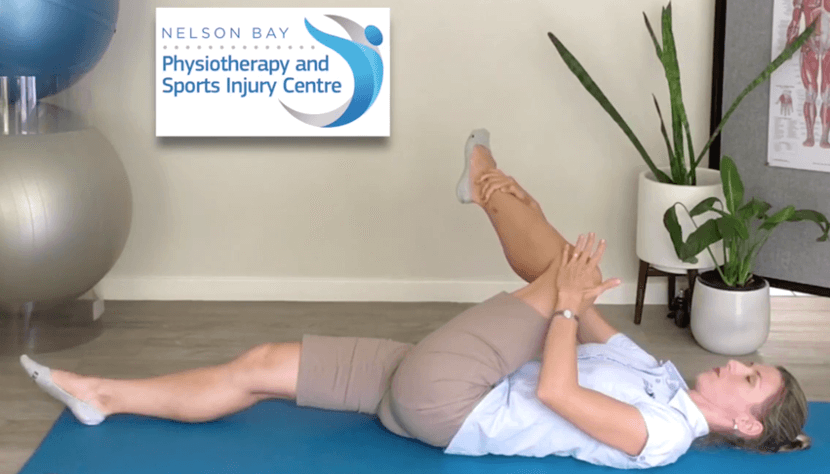Exercise Extra – Piriformis Stretch
February 12, 2022

The piriformis muscle is found at the back of the hip joint. It is a triangular muscle attaching to the pelvis, sacrum (bone joining your pelvis to your spine) and the femur (thigh bone, also the strongest long bone in the body). The muscle is deep and hence has the gluteus maximus overlying it and below the skin.
The piriformis is an external rotator of the thigh in standing, however when sitting the muscle abducts the thigh (takes the knee away from the adjacent knee). Just like the rotator cuff of the shoulder, the deep hip rotators, of which the piriformis muscle is a member, is an important muscle in holding the ball of the hip inside the socket.
Interestingly, this muscle has been shown to have anatomical variation, rarely existing as two separate strands in the belly but commonly found as a typical single muscle belly. What we do know is that the sciatic nerve runs adjacent to this muscle and so a change to the tone of the muscle and the mechanics of the area can directly effect the sciatic nerve.
Functionally this means the piriformis muscle helps to:
- abduct the thigh in sitting eg. like moving the legs to the outside of the car to prepare for standing up
- moving from one chair to another without standing up
- stabilising the pelvis when the trunk is rotated (eg. golf swing)
- controlling the balance of the pelvis when standing on a moving bus
This muscle can therefore often be involved in hip, knee, sacroiliac and lower back pain. Often people have referred to a more non-specific diagnosis of piriformis syndrome.
The muscle therefore has many uses associated with pelvic control, hip movement and general lower limb and trunk alignment. The muscle therefore can like many others, be irritated by a single excessive load, prolonged excessive loading or through inactivity. Commonly we see people with symptoms associated with excessive sitting, overloaded exercise (lifting, stairs, running), twisting of the hip in sport, stepping in a hole or falling on the hip.
Common Symptoms
This muscle as stated earlier, has an important function with a number of joints around the back and lower limb and therefore can be involved in producing a variety of symptoms from knee pain to sciatic pain. Most commonly symptoms directly associated with piriformis activity present similarly to sciatica, a condition often associated with nerve irritation in the lower back. The earlier mentioned piriformis syndrome results from the sciatic nerve getting compressed in the back of the hip locally by the contracted piriformis muscle. Therefore symptoms often associated with its local compression on the sciatic nerve include:
- tingling in the back of the buttock and possibly beyond and to varying degrees down the back of the leg
- pain with sitting or direct tenderness on the buttock to pressure
- pain that increases in the buttock with sitting or with some activity
Treatment
Often the best treatment is prevention. The team here at Nelson Bay Physiotherapy & Sports Injury Centre are experienced in treating this condition. Often the condition is prevented by sensible and frequent exercise patterns progressing in a graded manner. When someone has piriformis syndrome, there treatment includes advice regarding causative movements, corrective exercise (like found below) and manual therapy to restore resting muscle tone and joint mobility. Most of all, your physiotherapist, is very skilled in determining biomechanically whether this muscle is the messenger or the cause of some other deficiency of movement or strength. We will then advise you on what to do to correct this.
How to Stretch the Piriformis

This specifically stretches the piriformis. This can be useful for knee, hip and back pain when used appropriately.
- Lie on your back with your feet flat on the floor.
- Bring the knee of the leg you wish to stretch towards your opposite shoulder (up and across) using the hand of the same side
- Maintain your back on the floor
- Block the movement/keep the knee in that position with the same hand
- Loop a strap/towel around the ankle of the same leg using your opposite arm
- Maintain the knee bend at 90 degrees
- Pull the foot around to create a stretch in the back of the hip
- Maintain a hollow in the small of your back.
- When you feel a comfortable stretch, hold there.
- Hold for 30 seconds to 2 minutes.
- Switch sides and repeat.
Feel free to try this stretch. Please be aware this exercise is not for everyone and is best considered for individual prescription following the advice of your physiotherapist. STOP IMMEDIATELY and do not continue if you experience ANY pain.
Article by Scott Ward
References:
Norkin C.C. & Levangie P.K. (1992). Joint Structure and Function: A Comprehensive Analysis (2nd Ed).
Palastanga N., Field D., & Soames R. (2000). Anatomy and Human Movement: Structure and Function (3rd Ed.).
